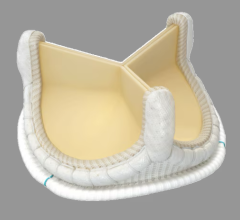
January 25, 2017 — Survival statistics, surgeon-specific experience and complication rates are the types of information most wanted by parents of children with congenital heart disease, according to a survey released at the 53rd Annual Meeting of The Society of Thoracic Surgeons (STS).
STS launched public reporting of outcomes from its Congenital Heart Surgery Database (CHSD) in early 2015, as a continuation of its commitment to increase public awareness and understanding of cardiothoracic surgery procedures. Public reporting of outcomes from the STS Adult Cardiac Surgery Database began in 2010.
“Public reporting for congenital heart surgery is definitely a work in progress, with the diversity of the field and wide spectrum of congenital heart defects being some of the greatest challenges. Each hospital’s case mix is unique, as are the specific defects treated at the individual institutions. This makes the comparison of outcomes across many different hospitals difficult,” explained Mallory L. Irons, M.D., MBE, from the Hospital of the University of Pennsylvania in Philadelphia. “Our research emphasized that parents have valuable opinions about the content and format of the information that should be provided. How data are presented may be more important than the data itself, with the type of visual display employed affecting the degree to which parents correctly interpret the data presented.”
Irons, along with members of the cardiothoracic surgical team at Children’s Hospital of Philadelphia (CHOP) and three parent advocacy groups (Mended Little Hearts, the Pediatric Congenital Heart Association and Sisters by Heart), developed a 43-question survey to assess parent attitudes regarding the format and content of an “optimal” public reporting scheme. Survey questions evaluated demographic and socioeconomic information, as well as the parents’ perspectives about the importance of various potential surgical outcome measures and the preferred graphical format of displaying outcomes data.
Parents were solicited for participation via member lists from the three parent advocacy groups and from a cohort of parents whose children had undergone surgical correction for an STS benchmark procedure at CHOP after Jan. 1, 2007. Of the 1,862 survey responses collected, 1,281 (69 percent) provided complete data for analysis. Nearly all (92 percent) of the participants were mothers of children with congenital heart disease (CHD).
In their responses, parents identified survival statistics, surgeon-specific experience and complication rates as the most important congenital heart surgery outcome measures to publicly report. Additionally, when presented with three display formats for hospital-specific mortality rates, most parents (89 percent) preferred a numerical, procedure-based approach as the best format, and more than half (60 percent) thought the hospital star rating system was the least desirable format to display mortality data.
Researchers hypothesized that parents preferred the numerical, procedure-based format because it allows them to see mortality data for a specific procedure. But for procedures that are performed less frequently, the numbers may be too small for surgeon-specific outcomes to be meaningful enough for families faced with a choice. Consequently, as public reporting of congenital heart surgery outcomes continues to evolve, Irons said, the optimal reporting scheme may be a hybrid of the numerical, procedure-based format and star rating system, providing overall rankings along with procedure-specific data.
While the American Heart Association (AHA) identifies at least 18 distinct categories of congenital heart defects, with many additional anatomic variations, the STS CHSD actually contains data pertaining to almost 200 unique diagnoses and more than 150 different types of surgical procedures. Congenital heart defects are the leading cause of all infant deaths in the United States, with approximately 40,000 babies born with at least one congenital heart defect in the U.S. each year, according to the U.S. Centers for Disease Control and Prevention.
Achieving adequate risk adjustment also presents problems in the public reporting of outcomes in congenital heart surgery. Risk adjustment is a way to measure surgical results by taking into consideration how sick the patients were before treatment. “Many factors, such as preterm birth, genetic anomalies and extra-cardiac anomalies may significantly alter the procedural risk for an individual patient, but current risk models still do not include many factors that may increase the risk of death,” said Irons.
“Efforts for public reporting like those developed by STS are very important,” said Irons. “The organization strives to report results that are based on accurate data, robust outcomes and risk adjustment, and are presented in an easily understood format. In promoting transparency in the reporting of outcomes, not only do we help patients and their families make decisions about where and from whom to receive care, but we also strive to improve outcomes across all centers.”
According to the research group, future efforts in public reporting for congenital heart surgery outcomes must include more robust risk adjustment, long-term outcomes, and better methods for presenting the data in a valid, easily interpreted format that meets the unique needs of parents and other stakeholders. “Moving forward, the challenge will be to find ways to meet the goals of all stakeholders, without compromising the quality of data,” Irons said.
“This study has helped clarify what types of information parents want; however, just because parents want certain data does not mean that we can provide this in a meaningful way,” concluded Irons. “Our ultimate goals with this project were to improve patient care and understand how the public reporting effort can help attain this goal.”
The CHSD — a component of the STS National Database — is the largest clinical database in the world dealing with congenital cardiac malformations. The CHSD contains more than 400,000 congenital heart surgery procedure records and currently has more than 800 participating physicians, including surgeons and anesthesiologists, representing more than 95 percent of all congenital heart surgery hospitals in the United States and Canada. STS also has available a CHSD mortality risk model that calculates the operative mortality rate of hospitals performing pediatric and congenital heart surgery, adjusting for procedural and patient-level factors.
STS voluntary reporting of hospital-level outcomes from pediatric and congenital heart surgery currently includes both star ratings (as used in all STS National Database public reporting) and actual numerical data for observed and risk-adjusted rates of operative mortality (provided as point estimates with confidence intervals), with these data reported both for all operations and for risk stratified groups of operations.
The other authors of the study were J. William Gaynor, M.D.; Thomas L. Spray, M.D.; and Chris Feudtner, M.D., Ph.D.
For more information: www.sts.org



 April 23, 2024
April 23, 2024 








